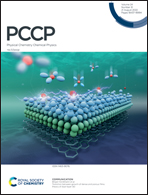Molecular investigations of the prenucleation mechanism of bone-like apatite assisted by type I collagen nanofibrils: insights into intrafibrillar mineralization†
Abstract
Bone is a typical inorganic–organic composite material with a multilevel hierarchical organization. In the lowest level of bone tissue, inorganic minerals, which are mainly composed of hydroxyapatite, are mineralized within the type I collagen fibril scaffold. Understanding the crystal prenucleation mechanism and growth of the inorganic phase is particularly important in the design and development of materials with biomimetic nanostructures. In this study, we built an all-atom human type I collagen fibrillar model with a 67 nm overlap/gap D-periodicity. Arginine residues were shown to serve as the dominant cross-linker to stabilize the fibril scaffold. Subsequently, the prenucleation mechanism of collagen intrafibrillar mineralization was investigated using a molecular dynamics approach. Considering the physiological pH of the human body (i.e., ∼7.4), HPO42− was initially used to simulate the protonation state of the phosphate ions. Due to the spatially constrained effects resulting from the overlap/gap structure of the collagen fibrils, calcium phosphate clusters formed mainly inside the hole zone but with different spatial distributions along the long axis direction; this indicated that the nucleation of calcium phosphate may be highly site-selective. Furthermore, the model containing both HPO42− and PO43− in the solution phase formed significantly larger clusters without any change in the nucleation sites. This phenomenon suggests that the existence of PO43− is beneficial for the mineralization process, and so the conversion of HPO42− to PO43− was considered a critical step during mineralization. Finally, we summarize the nucleation mechanism for collagen intrafibrillar mineralization, which could contribute to the fabrication of mineralized collagen biomimetic materials.



 Please wait while we load your content...
Please wait while we load your content...